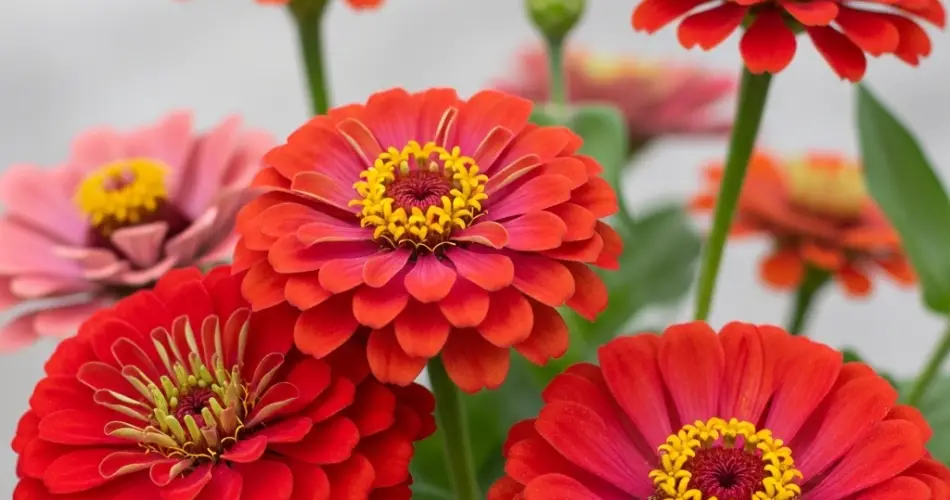Zinnias are a favorite among gardeners for their bright, cheerful blooms and ability to attract pollinators. These low-maintenance annuals typically thrive in sunny spots and are relatively easy to care for. However, it can be frustrating to see your zinnias suddenly start to wilt despite your best efforts. If your zinnia plants are looking droopy, don’t panic—there are several common causes, and many of them are easy to fix with the right approach.
In this guide, we’ll explore the possible reasons your zinnias are wilting and walk you through the steps to revive them and get them blooming again.
1. Underwatering or Overwatering
The most common reason zinnias wilt is inconsistent watering. These plants prefer well-drained soil and do not like to sit in water, but they also don’t tolerate prolonged drought.
Signs of underwatering:
-
Drooping leaves that feel dry or crispy
-
Soil that’s pulling away from the edges of the pot or garden bed
-
Leaves turning brown or curling
Signs of overwatering:
-
Soft, limp stems and leaves
-
Yellowing foliage, especially near the base
-
Constantly wet or soggy soil
Solution:
Check the soil moisture before watering. If the top inch of soil is dry, it’s time to water. If it still feels damp, hold off. Always water at the base of the plant and avoid soaking the foliage. For container zinnias, ensure pots have proper drainage holes.
2. Poor Drainage
Zinnias hate “wet feet.” If your garden soil doesn’t drain well or your container lacks proper drainage, water will collect around the roots and lead to root rot, which causes plants to wilt.
Solution:
Amend heavy garden soil with sand, compost, or perlite to improve drainage. If growing in pots, make sure the containers have multiple drainage holes and use a light, well-draining potting mix. You can also elevate pots slightly off the ground to allow water to escape more easily.
3. Fungal Diseases
Wilting may also be caused by fungal infections such as Fusarium wilt or root rot, which attack the plant’s vascular system and prevent it from absorbing water properly.
Common symptoms:
-
Leaves suddenly wilt and collapse, even if the soil is moist
-
Dark streaks or discoloration on stems
-
No improvement after watering
Solution:
Remove and discard infected plants to prevent the spread to others. Avoid overhead watering, and always water early in the day so foliage can dry before nightfall. Rotate crops in the garden and avoid planting zinnias in the same spot each year if disease persists.
4. Heat Stress
Although zinnias love full sun, extreme heat can lead to temporary wilting, especially if plants are in shallow soil or containers that dry out quickly.
Solution:
Water deeply in the early morning or late evening when temperatures are cooler. In extreme conditions, provide temporary shade using cloth or garden umbrellas during the hottest part of the day. Mulching around the base of plants can also help retain soil moisture and regulate temperature.
5. Pest Infestations
Certain pests such as aphids, spider mites, or whiteflies can sap moisture from zinnia leaves and stems, leading to wilting and yellowing. They are often found on the undersides of leaves and can multiply quickly in warm weather.
Solution:
Inspect plants regularly and remove pests by spraying them with a strong stream of water. For more serious infestations, use insecticidal soap or neem oil. Encourage beneficial insects like ladybugs and lacewings that feed on common pests.
6. Transplant Shock
If you’ve recently moved your zinnias from one spot to another or planted young seedlings, wilting may be a response to transplant shock. Roots take time to adjust, especially if they were disturbed during the process.
Solution:
Keep the soil consistently moist (not soggy) and protect young plants from direct sun for a few days after transplanting. Adding a mild fertilizer or root stimulator may help the plant recover more quickly.
7. Nutrient Deficiencies
Wilting can also result from a lack of essential nutrients, particularly potassium and phosphorus, which support root strength and water uptake.
Solution:
Feed your zinnias every 2–4 weeks with a balanced, water-soluble fertilizer during the growing season. Avoid high-nitrogen fertilizers, which promote foliage growth at the expense of blooms and may make the plant more susceptible to stress.
Final Tips to Keep Zinnias Thriving
-
Grow zinnias in full sun for at least 6–8 hours per day.
-
Space them properly to allow airflow, reducing the risk of disease.
-
Water at the base and avoid splashing soil onto leaves.
-
Deadhead spent blooms regularly to encourage more flowers and stronger plants.
Conclusion
Wilting zinnias don’t necessarily mean your garden is doomed. With a little observation and timely action, most issues can be reversed, and your plants can bounce back quickly. Whether it’s adjusting your watering routine, checking for pests, or improving drainage, giving your zinnias the right care ensures they’ll reward you with vibrant blooms all season long.



